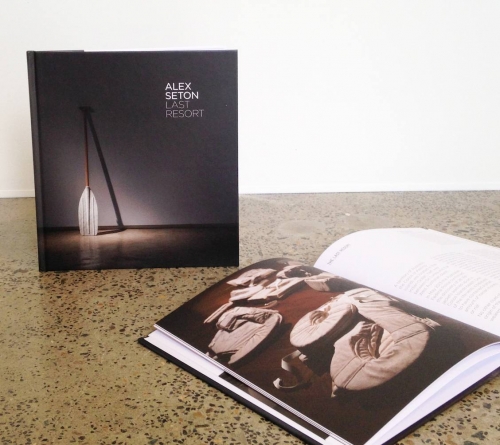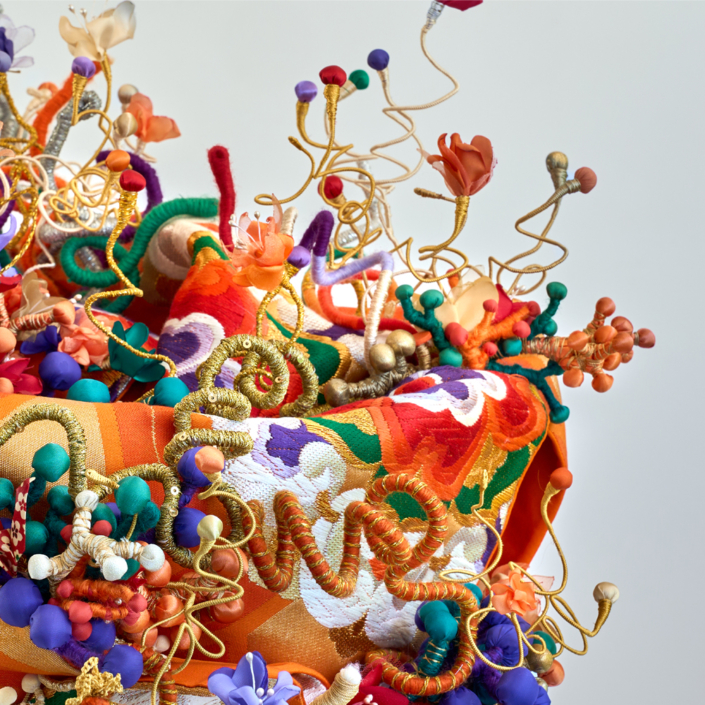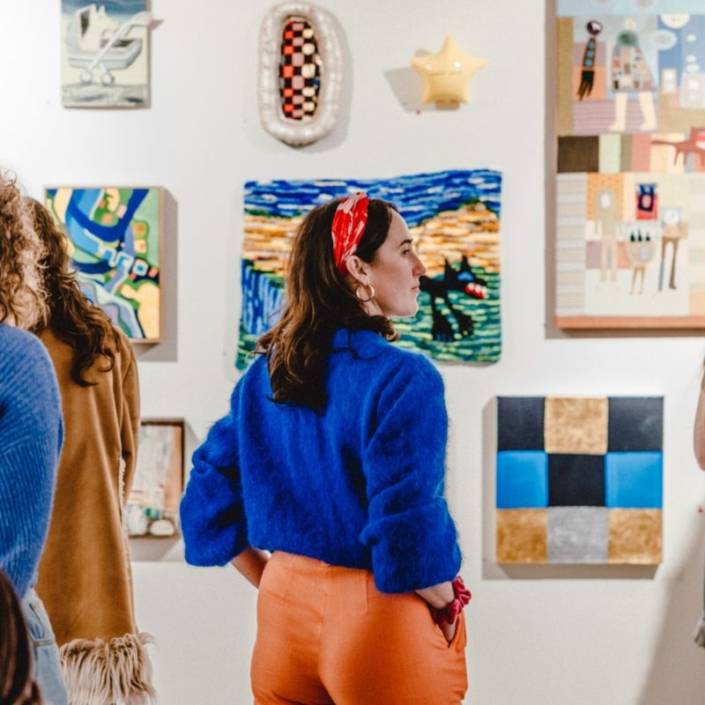Alex Seton: This is what it looks like
Over the last few years, Alex Seton has through his marble works engaged in one of the most hotly debated Australian political issues of recent times – asylum seekers.
Words: Andrew Frost
Photography: Zan Wimberely
On a large white board in Alex Seton’s studio is a drawing of the works that will be seen in a trio of exhibitions to be staged between October and December 2014. For anyone who knows Seton’s recent work, or is familiar with its evolution over the last few years, its subject is familiar. Seton has engaged with one of the hottest political topics of the last decade – asylum seekers.
Across the two floors of Sullivan+Strumpf gallery in Sydney, Seton plans to install an array of marble sculptures, some simulating the life jackets used by both asylum seekers and Naval personnel, others offering a far more acerbic take on the situation in the form of pool toys and other fun inflatables. Seton’s exceptional skills as a sculptor and his fidelity to the exact reproduction of objects is the crucial conceptual play of the show. The tension between the actuality of something – an event, an object – and the way it can exist both as something literal, and as a metaphor, is the idea that lays at the heart of Seton’s art.
“This whole body of work is an extension of the work I did at the Adelaide Biennial Someone Died Trying to Have a Life Like Mine,” says Seton. “That was the creation of 28 life jackets in marble that were scattered around the floor, a replication of the life jackets that had washed up on the shore of the Cocos Islands in May 2013.” Seton explains that his motivation to make the Biennial work, and this new series of sculptures, comes from a desire to understand and recognise his own role as an observer of these events. “I’m an artist,” says Seton. “I retain the right to respond emotionally to a political issue. I don’t claim to have political answers, or answers at all, but what I had often wondered when I listened to people talking about ‘turning back the boats’ [was] what does that look like? This is what it looks like. That’s the object.”
Upstairs at Sullivan+Strumpf the exhibition features an array of full-scale marble facsimiles of pool toys including play-version zodiac life boats – whose full scale cousins transport Australia’s border protection forces – and palm trees atop a fake island of marble rubble. Seton describes this suite of works – that sit alongside a trio of replicas of life jackets – as a “sickly sweet satire” that stand in contrast to the drama of the other works. “The way we treat outsiders in our society has always been of interest to me. The asylum seeker issue had been something that I’ve been thinking about for a while and that’s because it speaks more to who we are.”
Seton’s exhibitions propose a conceptual tension between real objects and their representations in marble, a material associated with wealth and status. “In the past I’ve used marble to look at things like symbols of empire or the memorialisation of the everyday,” he says. “There’s a privilege that goes with these over-manicured pool toys but [the exhibition] is also about the material of marble being a signifier of wealth that’s held over other people.”
Does Seton wonder whether people who buy his work are in some way communing with his point of view? Or is it an aesthetic response to the very tactile and luxurious quality of the work? “I bloody well hope it’s the latter,” he says without hesitation. “Preaching to the converted isn’t of interest to me. In and of itself, my work doesn’t take much of a political stand; it’s simply laying bare the humanity of an issue. I hope that comes out. I try to remain neutral about it. I don’t want to knock people over the head with it, but the context is undeniable. I try to create a context around an object. I’ve developed a trust in the audience and that they will understand in some way.”
Alex Seton’s new work will be seen at Sullivan+Strumpf in Sydney from 16 September to 11 October. Elements of the show will also be exhibited at Linden Center for Contemporary Arts, Melbourne from 20 December to 22 February and at McClelland Gallery & Sculpture Park, Victoria from 16 November to 15 January.
Joanna Strumpf
CO-DIRECTOR, SULLIVAN+STRUMPF
Joanna Strumpf, who with Ursula Sullivan co- directs Sullivan+Strumpf in Sydney, saw one of Alex Seton’s early works and was immediately drawn by its match up of unlikely subject and materials – an exact replica of a garbage bag made of black Belgian marble. “Alex’s use of marble, with all of its potency and tradition, connects with a contemporary audience,” says Strumpf. “And there’s a certain theatricality in the work which appeals to me too.” Since first exhibiting Seton’s work in 2008, Sullivan+Strumpf has worked closely with the artist on a number of large-scale projects. “Alex understands the importance of working as a team, which is something that we have done very successfully,” she says. “I remember fondly a long lunch that Alex, Ursula and I had post-exhibition in 2010 – patting ourselves on the back for all of our good work – but also plotting and planning for the future between courses. Alex is someone with tremendous energy; something that you feel the moment you enter the studio. It’s great to be around.” The gallery has taken Seton’s work to a number of international art fairs – did the topical nature of its subjects translate in an international context? “Exhibiting Alex’s work overseas is tremendous fun. Audiences are unafraid of engaging directly with the work and are endlessly fascinated by the medium. This year at Art Basel Hong Kong we presented two works – an inflatable crown and an upright life vest – both carved in Bianco Carrara marble. These works and their bronze editions found homes in Asia. While the works on one level are about current Australian political concerns, there are other ideas surrounding them that need no translation.”
Nick Mitzevich
DIRECTOR, ART GALLERY OF SOUTH AUSTRALIA
“I first developed an interest in Alex Seton’s work as director of the Newcastle Art Gallery, some 10 years ago,” says Nick Mitzevich, now director of the Art Gallery of South Australia. “I was really drawn to the materiality of his work but more importantly his commitment to taking a very classical medium and infusing it with a contemporary attitude.” Mitzevich has also observed a change in Seton’s work in recent years. “Seton’s work has really advanced in the last few years,” he says. “He’s not afraid to take on big ideas and be ambitious with his projects. He also has a strong commitment to developing his technical ability and as a result his works have become more and more conceptually and materially sophisticated over time. Alex tackles big issues; his work beguiles us with its subtle beauty, however the real punch comes with how he grapples with ideas that are important in society.”
The Art Gallery of South Australia recently acquired a major piece by Seton for its collection. “Seton’s moving sculpture Someone died trying to have a life like mine has been acquired into the gallery’s collection, through the Directors Project, a fund set up to secure extraordinary, innovative art projects that will broaden the collection of the Art Gallery of South Australia. Seton’s solemn marble re-enactment of an incident whereby the lifejackets of 28 asylum seekers were discovered washed up on Cocos Island was one of the most talked about works of art in this year’s Adelaide Biennial.”
This article was originally published in Art Collector issue 70, OCT – DEC 2014.
FOLLOW THIS ARTIST
PURCHASE ALEX SETON: LAST RESORT
$35
Shipping included










